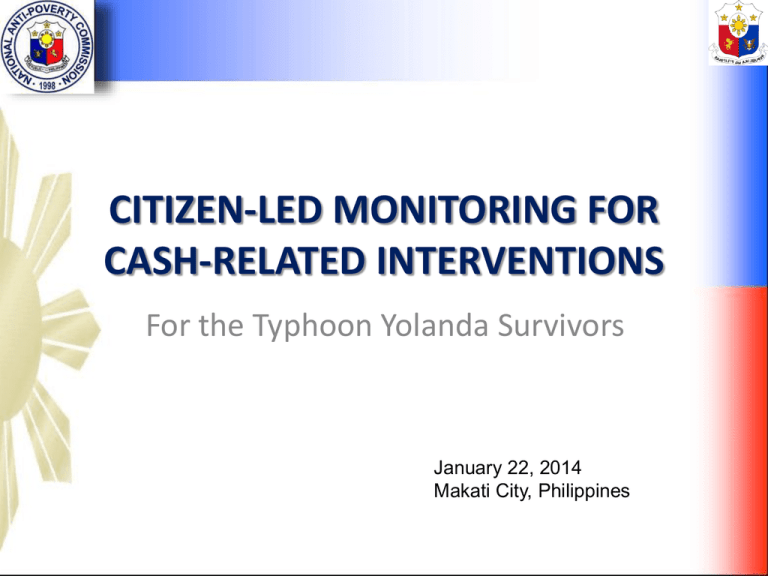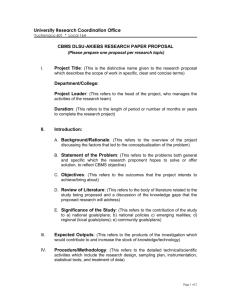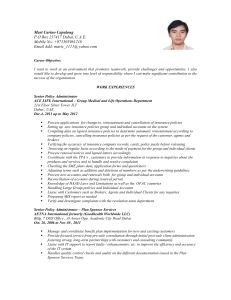Citizen-led Monitoring for cash-related
advertisement

CITIZEN-LED MONITORING FOR CASH-RELATED INTERVENTIONS For the Typhoon Yolanda Survivors January 22, 2014 Makati City, Philippines The National Anti-Poverty Commission (NAPC) • The government’s chief agency for poverty reduction • Institutionalizes basic sector representation and participation in the government’s poverty reduction programs. • Wields advisory and oversight powers for the formulation and implementation of social reform and poverty reduction programs. ORGANIZATIONAL STRUCTURE HIS EXCELLENCY PRES. BENIGNO S. AQUINO III (Chairperson) SEC. JOEL ROCAMORA (Lead Convenor) NAPC SECRETARIAT VICE CHAIRPERSON for Government Sector Members: 25 Heads of NGAs 4 Presidents of Leagues VICE CHAIRPERSON Atty. Marlon Manuel for Basic Sector Members: 14 Basic Sectors NAPC MEMBER AGENCIES Cooperative Development Authority Commission on Higher Education Council for the Welfare of Children Department of Agriculture Department of Budget and Management Department of Education Department of Environment and Natural Resources Department of Finance Department of Health Department of the Interior and Local Government Department of Labor and Employment Department of Agrarian Reform Department of Social Welfare and Development Department of Trade and Industry Housing and Urban Development Coordinating Council Philippine Commission on Women National Commission on Indigenous Peoples National Disaster Risk Reduction and Management Council National Economic Development Authority National Youth Commission Office of the Presidential Adviser on the Peace Process People’s Credit and Finance Corporation Presidential Commission for the Urban Poor ______ Liga ng Mga Barangay League of Municipalities of the Philippines League of Cities of the Philippines League of Provinces of the Philippines BASIC SECTORS-NGA PARTNERSHIP SECTOR Artisanal Fisherfolk Children Cooperatives Farmers Indigenous Peoples NGOs Persons with Disabilities Senior Citizens Urban Poor Victims of Disasters Women LEAD AGENCY Dept. of Agriculture (DA) Dept. of Social Welfare and Devt. (DSWD) Cooperative Devt. Authority (CDA) Dept. of Agriculture (DA) National Commission on Indigenous Peoples (NCIP) National Economic and Development Authority (NEDA) Dept. of Health (DOH) Dept. of Social Welfare and Devt. (DSWD) Presidential Commission for the Urban Poor (PCUP) National Disaster Risk Reduction and Management Council (NDRRMC) Philippine Commission on Women (PCW) Workers in the Formal Sectors and Migrant Workers Department of Labor and Employment (DOLE) Workers in the Informal Sectors Department of Labor and Employment (DOLE) Youth and Students National Youth Commission (NYC) The Concept of Citizens as Monitors The post-Martial Law period has opened opportunities for citizen participation in governance, and project conceptualization and planning to implementation and monitoring Because of these opportunities, capability building and development activities have been strengthened either through inter-civil society organization (CSO) or basic sector organization (BSO) cooperation, or through government-CSO/BSO cooperation “NGOs training BSOs and people’s organizations” Office of the Ombudsman training and accrediting CSOs as corruption prevention units; NAPC providing capability development trainings to BSOs on project monitoring The practice of citizen-led monitoring in the Philippines has been found effective in the implementation of public works projects, delivery of basic services, and the budgeting process. Citizen-led monitoring ensured that the projects are implemented properly or the services are received by the target recipients Empowered the citizens to become active partners in governance. NAPC’s current projects involving citizens as monitors: Citizen-led monitoring project for bottom-up budgeting – local poverty reduction action planning (BUB-LPRAP) Rapid Community-Based Monitoring System (Rapid CBMS) Other government projects through the basic sector council members The Proposal: Citizen-led Monitoring for PostYolanda Cash-Related Interventions Features • Engagement of citizens as third party monitors – Must be members of legitimate basic sector/civil society organizations – Must satisfy other criteria including knowledge of the local geographic and even socio-political terrain, experience in project monitoring, etc. • Utilization of information-technology based tools to expedite data gathering (i.e., Rapid technology being used in Rapid CBMS developed by NAPC) RAPID CBMS PROCESS Data Transmission Data Collection EVIDENCEBASED PLANNING and MONITORING Data Processing, Presentation, Visualization Community Data Validation • Focus will be on: – The process of implementation of cash-related interventions for Yolanda survivors – Timely release of funds to the beneficiaries – Gathering of baseline information for the evaluation of results or impacts – Other realistic targets as may be agreed upon • Possible methodologies and tools – Review and analysis of documents including financial statements – Spot checks – Interviews and focus group discussions Project Implementation Preparatory Activities •Stakeholder consultations •Development of monitoring tools & instruments •Selection of areas (if sampling) •Selection and orientation of monitors Actual Monitoring • Data gathering • Review and analysis of data Reporting • Report preparation • Report presentation Thank you…



